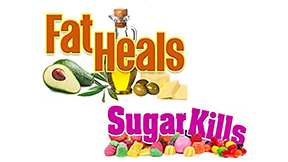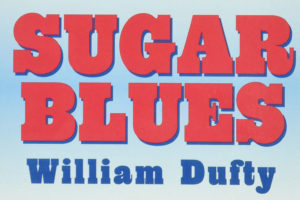 by Dr. Bruce Fife
by Dr. Bruce Fife
Chapter 4, Part 3
Advanced Glycation End-Products (AGEs)
My Initial Comments: I wish I had known in my younger years just how potentially destructive sugar is on one’s health. Hopefully my sugar addiction from decades ago didn’t do any permanent damage. As I continue to read and understand from several experts who have researched this subject, it’s clear that the average person’s consumption of sugar is unhealthy.
Understanding the destructiveness of Advanced Glycation End-Products (AGEs) is really important if you consume refined sugars and are concerned about your health.
Sadly, I have spoken with too many people that preferred to continue with their sugar addiction and their resulting prescription addiction. Why do so many insist to continue with this insanity? I think much of it has to do with the same reasons that people are addicted to caffeine, nicotine, alcohol, mind altering drugs, and behaviors such as gambling. It teases our dopamine part of our brains. It’s pleasurable.
However, what we eat or drink, are behaviors, and we can choose what we will and what we won’t eat. We can choose to pass up the sweets when everyone around us is indulging. We can tell ourselves that the momentary pleasure I get from eating that doughnut or other sweet treat isn’t worth the damage it does to my health. We can choose to be the captain of our own ship.
At a recent family reunion everyone else was partaking of the pie and ice cream dessert except for my wife and I. She refrained due to food allergies, and I passed up the dessert as I didn’t want to fall off the wagon. I’d rather just “say no” to the high sugar eats and treats. Yes, it’s hard to do, initially, but once you get in the habit of doing so, it becomes much easier.
Continuing:
Dr. Fife begins this section by stating that sugar accelerates the aging process making you look and feel much older than you really are. He explains that elevated blood glucose levels increase molecular entities known as advanced glycation end-products or AGEs for short. The sticky glucose in your bloodstream could stick to fats, but it’s especially attracted to proteins.
He points out that aging is the accumulation of damaged cells.
The more AGEs you have in your body, the “older” you become functionally regardless of how many years you’ve lived. AGEs adversely affect other molecules generating free radicals, oxidizing LDL cholesterol (thus creating the type of cholesterol that collects in arteries and promotes atherosclerosis, heart attacks, and strokes), degrading collagen (the major supporting structure in our organs and skin), damaging nerve tissue (including the brain), and wreaking havoc on just about every organ in the body. AGEs are known to play an important role in the chronic complications of [type 2] diabetes and in the development of Alzheimer’s, Parkinson’s, and other neurodegenerative diseases. [Ed: My emphasis]
My comments: Many people will read the above paragraph and will say, yeah, yeah, I know all of that only to continue to indulge in what’s causing these various degenerative illnesses. When they see their doctor next, the doc is concerned because their A-1C is up, their blood pressure reading is up, and/or their “bad” LDL cholesterol is up. Solution? You guessed it: Up the dose of the meds and maybe a new one.
The doctor might give lip service about better nutrition, but that’s about it. The doc might even comment that you need to get your weight down by 15 or 20 pounds, but that about as far as it goes.
You the patient do not have to agonize by quitting your sugar addiction; the doc doesn’t have to fight to get a reluctant patient to change his/her lifestyle; the pharmacist will dutifully fill your prescriptions; and everyone is happy, or so they think.
Continuing: Dr. Fife explains that the AGE’s process is understood simply by observation. AGEs are involved in a vicious cycle of inflammation, generation of free radicals, amplified production of AGEs, more inflammation, and so on.
He goes on to say that everyone experiences the effects of AGEs to some extent and that it’s a part of getting older. The effects are the loss of skin tone, decreased organ function, reduction of motor skills, reduced ability to fight off infections, and other aging issues.
The problem is that insulin resistance raises blood glucose levels. Chronically elevated blood glucose levels can remain high even with the use of medications. The longer glucose is in contact with proteins, the greater the opportunity they have of forming AGEs. High blood sugar accelerates AGEing. [Ed: My emphasis]
Fortunately, we are not totally defenseless against the formation of AGEs. Our white blood cells have receptors to latch on to the AGEs and remove them. However, not all of them are easily removable, as this process sets off an inflammatory response. This, in turn, can lead to chronic inflammation.
Fife continues by explaining that heart disease is the leading cause of death in diabetics, and that heart disease is caused by diseased arteries. Studies have shown that the destructive effects of AGEs on blood vessels accounts for the rapidly progressive atherosclerosis experienced by diabetes.
It is this chronic high blood sugar characteristic of diabetics that leads to deterioration of the arteries that causes peripheral vascular disease, diabetic retinopathy, kidney disease, and other diabetic complications. …Elevated blood sugar itself, whether diabetes is diagnosed or not, is considered a risk factor for heart disease. [Ed: My emphasis] Elevated blood sugar is referred to as hyperglycemia.
Fife continues by explaining that AGEs have been identified as the primary mechanism that initiates the steps the lead to the development of atherosclerosis.
AGEs are highly damaging to the integrity and function of the blood vessel walls. They easily attach themselves to artery walls, generating free radicals and chronic inflammation. As tissues break down, proinflammatory cytokines, growth factors, and adhesion molecules are generated. Blood proteins, immune cells, LDL cholesterol, and fats infiltrate the damaged artery tissue where they are trapped. Cholesterol and fats are oxidized, and more inflammation is generated.
And now the process of occluded (partially, plugged, blocked, or restricted) artery vessels in your heart is in full swing.
My Comments: I have a father and brother that both had a coronary bypass surgery due to mostly blocked coronary arteries. A few years later they both died from heart illness. My paternal grandfather never made it to the surgeon’s table. He died from a massive stroke at 69.
The wife of my deceased brother Alan warned me about how heart disease was running in the males in our family. She urged me to see a specialist and have all sorts of tests done Her perspective was that she had seen three generations of men die from artery related disease. I responded with the following explanation:
I pointed out to her that the common factor was that all three were once very overweight and consumed way, way too many sugar-laden foods. I also reminded her that the potato chips Alan ate contained unhealthy fats which likely were a contributory factor towards his heart illness.
The real irony is that the wives were unwitting enablers to their husbands’ illnesses. My paternal grandmother lived in Yuba City, CA, the peach tree capital of at least California. She baked plenty of peach pies. After all, who could turn down her tasty culinary efforts? Sadly, Grandpa was at least 40 pounds overweight. He was warned about his high blood pressure, but it was too late.
My mother, although a dietician by training, also did plenty of baking. There were the cookies, pies and cakes for special occasions and rich Christmas candies of various sorts. I would be woefully guilty of omitting important details if I failed to mention the fact that the household of my upbringing laid the seedbed for my sugar addiction. My sister-in-law wasn’t a baker, but she purchased plenty of unhealthy processed and sugary foods.
Isn’t it ironic that the wives who care about and love their husbands bake their husbands on their way to diabetes, heart disease, strokes, and a premature death? What are two most common ingredients of most baked goods? Yep, you guessed it, sugar and white, relined flour. And then you throw in unhealthy fats made from seed oils (aka vegetable oils) such as soybean and canola oil. To add insult to injury, you use the hydrogenated forms of these oils which are margarine and shortening.
I have been in households where the wives’ love of baking has contributed to their husbands being overweight, spiked their blood sugar, and been a factor in their diagnosis of adult onset diabetes.
Continuing:
Advanced Glycation End-Products (AGEs) have the following characteristics:
- They serve no useful purpose whereas cholesterol is needed for cellular function.
- They are toxic by-products of non-enzymatic reactions between sugar and body tissues and are highly destructive.
- They tend to increase with age.
- In addition to diabetes and heart disease, elevated levels of AGEs are often associated with kidney disease, Alzheimer’s disease, rheumatoid arthritis, and other maladies.
Dr. Fife explains that various studies show the connection between diets with high levels of refined carbohydrates and the acceleration of the aging process. The research also found that indicators of inflammation, oxidative stress, and insulin resistance increased with age regardless of the subject’s [actual] age.
It’s not how old you are but how much accumulated damage you have sustained that really determines you level of health. Dr Fife concludes this section by saying that the formation of AGEs is an ongoing process but that we can minimize the problem my reducing our sugar and refined carbohydrate consumption.
My comments: I think to speak in terms of “reducing our sugar and refined carbohydrate consumption” is like telling a smoker to reduce the number of cigarettes he/she smokes. While reducing the number of cigarettes is an improvement, kicking the habit far more beneficial.
How much are you going to reduce your consumption of sugar and other refined carbs? If you drink two cans of pop per day, do you reduce it to one? Do you cut in half the number of times you have pie and ice cream? If you normally have four cookies, do you only have two?
My take is that if you know you are addicted to sweets and refined carbs, the very best thing to do is to kick the addiction. Which is better for an alcoholic, cut a two or three per day beer habit to one six pack per week or to eliminate the consumption of all alcoholic beverages?
Maybe you the reader might be different, but I know what can happen to me. If I have just one cookie, then I want a second and so on. For me, it’s better and easier to abstain.
Another big bonus of avoiding refined carbohydrates is that it’s much easier to either lose weight or to maintain your desired weight. Needless to say, absolutely avoid putting toxic chemicals such as artificial sweeteners into your body. That’s a discussion for another time, but I’d hope for now that everyone would understand the nature never intended for you to ingest laboratory concocted chemicals into your body.
To be continued…

 by William Dufty
by William Dufty